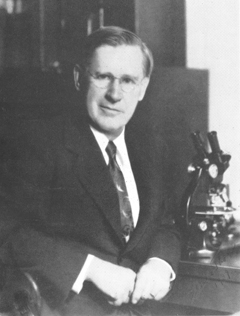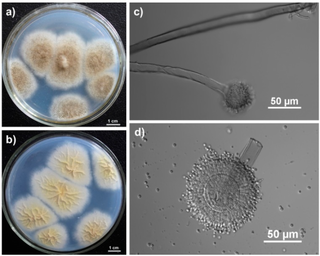
Penicillin is a group of antibiotics, derived originally from common moulds known as Penicillium moulds; which includes penicillin G, penicillin V, procaine penicillin, and benzathine penicillin. Penicillin antibiotics were among the first medications to be effective against many bacterial infections caused by staphylococci and streptococci. They are still widely used today, though many types of bacteria have developed resistance following extensive use.
A simile is a figure of speech that directly compares two things. Similes differ from metaphors by highlighting the similarities between two things that must use "like" and "as", while metaphors create an implicit comparison. This distinction is evident in the etymology of the words: simile derives from the Latin word similis, while metaphor derives from the Greek word metapherein. While similes are mainly used in forms of poetry that compare the inanimate and the living, there are also terms in which similes are used for humorous purposes and comparison.

A mold or mould is a fungus that grows in the form of multicellular filaments called hyphae. In contrast, fungi that can adopt a single-celled growth habit are called yeasts.

Penicillium ascomycetous fungi are of major importance in the natural environment as well as food and drug production.

Blue cheese is a general classification of cheese that have cultures of the mold Penicillium added so that the final product is spotted or veined throughout with blue mold. This carries a distinct smell, either from that or various specially cultivated bacteria. Some blue cheeses are injected with spores before the curds form, and others have spores mixed in with the curds after they form. Blue cheeses are typically aged in a temperature-controlled environment such as a cave. Blue cheese can be eaten by itself or can be spread, crumbled or melted into or over a range of other foods.

The Eurotiomycetes are a class of ascomycetes within the subphylum Pezizomycotina.

The Trichocomaceae are a family of fungi in the order Eurotiales. Taxa are saprobes with aggressive colonization strategies, adaptable to extreme environmental conditions. Family members are cosmopolitan in distribution, ubiquitous in soil, and common associates of decaying plant and food material. The family contains some of the most familiar fungi, such as Penicillium and Aspergillus. It has been proposed that the family should be split into the three families Aspergillaceae, Thermoascaceae and Trichocomaceae.

Penicillium roqueforti is a common saprotrophic fungus in the genus Penicillium. Widespread in nature, it can be isolated from soil, decaying organic matter, and plants.

The history of penicillin follows a number of observations and discoveries of apparent evidence of antibiotic activity in molds before the modern isolation of the chemical penicillin in 1928. There are anecdotes about ancient societies using molds to treat infections, and in the following centuries many people observed the inhibition of bacterial growth by various molds. However, it is unknown if the species involved were Penicillium species or if the antimicrobial substances produced were penicillin.

Cyclopiazonic acid (CPA) is a toxic fungal secondary metabolite. Chemically, CPA is related to ergoline alkaloids. CPA was originally isolated from Penicillium cyclopium and subsequently from other fungi including Penicillium griseofulvum, Penicillium camemberti, Penicillium commune, Aspergillus flavus, and Aspergillus versicolor. CPA only appears to be toxic in high concentrations. Ingestion of CPA causes one to be an anorexic, to be dehydrated, to lose weight, to be immobile, and has some sign of spasm when near death. They can be found in molds, corns, peanuts, and other fermented products, such as cheese and sausages.Biologically, CPA is a specific inhibitor of SERCA ATPase in intracellular Ca2+ storage sites. CPA inhibits SERCA ATPase by keeping it in one specific confirmation, thus, preventing it from forming another. CPA also binds to SERCA ATPase at the same site as another inhibitor, thapsigargin (TG). In this way, CPA lowers the ability of SERCA ATPase to bind an ATP molecule.
Chrysovirus is a genus of viruses. It is the only genus in the family Chrysoviridae. They are class III double stranded RNA viruses which infect fungi, in particular Penicillium. Their name is derived from the Greek word chrysos which means yellow-green. There are currently nine species in this genus including the type species Penicillium chrysogenum virus.
Homeric simile, also called an epic simile, is a detailed comparison in the form of a simile that are many lines in length. The word "Homeric", is based on the Greek author, Homer, who composed the two famous Greek epics, the Iliad and the Odyssey. Many authors continue to use this type of simile in their writings although it is usually found in classics.

Penicillium chrysogenum or P. notatum (formerly) is a species of fungus in the genus Penicillium. It is common in temperate and subtropical regions and can be found on salted food products, but it is mostly found in indoor environments, especially in damp or water-damaged buildings. It was previously known as Penicillium notatum. It has rarely been reported as a cause of human disease. It is the source of several β-lactam antibiotics, most significantly penicillin. Other secondary metabolites of P. chrysogenum include roquefortine C, meleagrin, chrysogine, 6-MSA YWA1/melanin, andrastatin A, fungisporin, secalonic acids, sorbicillin, and PR-toxin.

Charles Thom was an American microbiologist and mycologist. Born and raised in Illinois, he received his PhD from the University of Missouri, the first such degree awarded by that institution. He was best known for his work on the microbiology of dairy products and soil fungi, and in particular his research into the genera Aspergillus and Penicillium. His work influenced the establishment of standards for food handling and processing in the USA. He pioneered the use of culture media to grow microorganisms, and, with food chemist James N. Currie, developed a process to mass-produce citric acid using Aspergillus. Thom played an important role in the development of penicillin in World War II.
Penicillopepsin is an enzyme. This enzyme catalyses the following chemical reaction
Penicillium citrinum is an anamorph, mesophilic fungus species of the genus of Penicillium which produces tanzawaic acid A-D, ACC, Mevastatin, Quinocitrinine A, Quinocitrinine B, and nephrotoxic citrinin. Penicillium citrinum is often found on moldy citrus fruits and occasionally it occurs in tropical spices and cereals. This Penicillium species also causes mortality for the mosquito Culex quinquefasciatus. Because of its mesophilic character, Penicillium citrinum occurs worldwide. The first statin (Mevastatin) was 1970 isolated from this species.
Penicillium simplicissimum is an anamorph species of fungus in the genus Penicillium which can promote plant growth. This species occurs on food and its primary habitat is in decaying vegetations Penicillium simplicissimum produces verruculogene, fumitremorgene B, penicillic acid, viridicatumtoxin, decarestrictine G, decarestrictine L, decarestrictine H, decarestrictine I, decarestrictine K decarestrictine M, dihydrovermistatin, vermistatin and penisimplicissin

Czapek medium, also called Czapek's agar (CZA) or Czapek-Dox medium, is a growth medium for propagating fungi and other organisms in a laboratory. It was named after its inventors, Polish botanist Friedrich Johann Franz Czapek and American chemist Arthur Wayland Dox. It was developed to grow Aspergillus niger and Penicillium camemberti. It works well for many saprophytic fungi and soil bacteria such as species of Aspergillus, Candida, Penicillium, and Paecilomyces.

Penicillium spinulosum is a non-branched, fast-growing fungus with a swelling at the terminal of the stipe (vesiculate) in the genus Penicillium. P. spinulosum is able to grow and reproduce in environment with low temperature and low water availability, and is known to be acidotolerant. P. spinulosum is ubiquitously distributed, and can often be isolated from soil. Each individual strain of P. spinulosum differs from others in their colony morphology, including colony texture, amount of sporulation and roughness of conidia and conidiophores.











